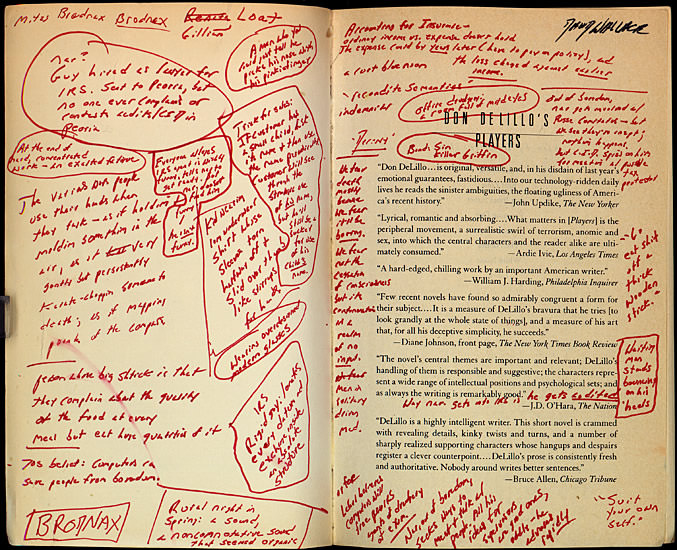
Harry Ransom Center, The University of Texas at Austin
Inside cover of David Foster Wallace’s annotated copy of Don DeLillo’s Players
Not long after the [iPad went on sale in early April] (http://www.nybooks.com/articles/archives/2010/jun/10/ipad-revolution/), the Ilinois Institute of Technology announced that it would be providing each member of next fall’s freshman class with one of the new Apple devices. School officials said that the iPad would allow students to take notes, check email, and read books. Which books they had in mind is not precisely clear except for this: they are not likely to be textbooks. While a number of publishers, like McGraw-Hill and Houghton Mifflin, have signed on with software developer ScrollMotion to produce textbooks for the iPad—works that would exploit its multimedia capabilities with video lectures, historical film clips, educational games, and interactive quizzes—almost none of those books yet exist. Students hoping to lighten their load (physical or monetary) by trading heavy, expensive textbooks for the 1.5 pound iPad will be disappointed, as early adopters of new technology often are. Pricing, already an issue for commercial books, is likely going to be even more controversial when it comes to textbooks. Will a new, improved, ebook version of “Atlas of Human Anatomy”cost the same as than the bell-less and whistle-less $149 paper edition? How much will students pay to have fun and exciting and clever textbooks that don’t actually exist in the material world?
For all its supposed interactivity, the iPad is a surprisingly static machine, especially for reading. And for the moment, few other universities are showing signs of embracing it for student use. One of the guilty pleasures of an actual, ink-on-paper book is the possibility of marking it up—underlining salient passages, making notes in the margins, dog-earing a page. While it’s true that some electronic book platforms for the iPad allow highlighting (it even looks like you’ve used a fat neon yellow or blue or orange marker), and a few—most notably Kindle and Barnes and Noble but not iBooks—allow you to type notes, they barely take advantage of being digital. It is not possible to “capture” your notes and highlights, to organize, compile, arrange, or to print them out. Until there is a seamless way to do this, marginalia will remain sequestered in the margins, and the promise of electronic books will be unrealized.*
There are work-arounds that can overcome some of the current drawbacks of the iPad and suggest where it needs to go. The one I’ve settled on is this: download to your iPad Amazon’s Kindle app—which allows you to read Kindle books on a non-Kindle device— then download an app called Browser Notes, and one called Print Bureau. (Only the Kindle app is free.) Using the Kindle app, highlight and take notes on whatever Kindle book you are reading. When the last page has been turned, open Browser Notes, type in the Kindle URL (kindle.amazon.com), go to the highlights you just made, select them all and copy them. Because Browser Notes offers a split screen, it is simple to tap on the lower half of the screen, hit paste, and see your highlights and notes. (There will not be quotation marks or pages numbers.) From here you can go to Print Bureau, open its clipboard, and print. Or you can email the file to yourself and print from Print Bureau’s email tab. Either way it’s a complicated choreography that requires a fair amount of concentration to avoid getting tripped up. Someday there may be an iPad app to get you there directly. Someday there may be a stylus and a way to physically write in the margins. Someday there may be optical character recognition software that turns those scribbles into manipulable text. Someday.
The iPad is a work in progress. Use it for a while and you will bump up against its limitations. When you do, you’ll find yourself missing the most utilitarian features of a laptop or PC—the mouse, the multitasking, the word processing. I’ll venture that this is intentional: just as the pre-release iPad publicity stirred up desire for the “magical” device, sight unseen, so the post-release iPad reminds users that they still want/need a more robust personal computer. When Apple opens a new door, it is careful not to shut the one behind it. The iPad has to be different enough from the company’s three other revenue streams—computers, iPods and iPhones—not to compromise their sales. There was a reason why, amid all the hype, the dominant sentiment was that the iPad was a “game-changer”—something you didn’t already own.
As it is built now, the iPad is the ultimate consumer device, meant primarily to consume media, not to produce it. That’s why, in its first iteration, it has no native printing application, no camera, no USB ports for peripherals. But the impulse to make it into something else, a lightweight computer that can stand in for a PC in the classroom, at a meeting, on the road, wherever, is strong. This is why iPad users have been buying keyboards to bypass the touchscreen, and finding apps that allow for rudimentary multitasking, printing, and remote access to one’s home computer in order to use non-iPad-enabled software like Microsoft Word. The paradox of having designed the ultimate consumer device is that ultimately the consumers will make of it what they want—if Google, with its rumored Chrome Tablet, doesn’t get there first.
Advertisement
- Editors’ note: At Apple’s Worldwide Developers Conference, Steve Jobs announced that the company would be addressing some of these issues in its next iBooks update, later this month.


